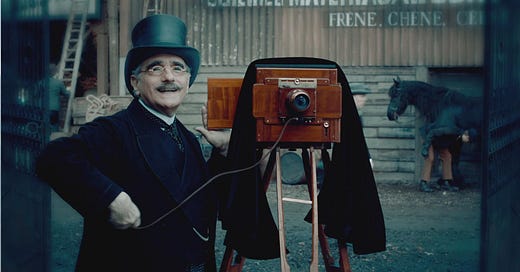The Long Take: How Martin Scorsese is literally saving cinema
These are the real theme park movies.
At 80, Martin Scorsese’s relationship with cinema has been so ubiquitous that anyone can point to at least one film he directed. He’s considered one of the greatest directors of all time, but he has his fair share of detractors. For some, his films - Taxi Driver, Raging Bull, Goodfellas, and The Wolf of Wall Street just to name a few - tend to be repetitive and monotonous, portraying a portion of unchecked American machismo that is made accessible to the undiscerning moviegoer. Scorsese has also voiced his criticisms of the modern state of the Hollywood landscape, describing the Marvel Cinematic Universe as ‘theme park movies’ and mentioned in an essay he wrote in Harpers about Federico Fellini, that streaming services do not prioritise curation, and are instead relying more on the content algorithm. Some have claimed that he is wrong on that criticism because they are more than mere entertainment. It’s easy to take these comments out of proportion and dismiss them as idealistic and Scorsese is not simply a person who has evidently made great movies, because there is another contribution of his that remains underappreciated.
Scorsese has taken an effort to restore the film worldwide. His organisation The Film Foundation is a non-profit founded by Scorsese that devotes itself to the duty of preserving cinema. It has many projects that set out to restore underseen works from around the world. So far, it has earned its reputation, according to the Directors Guild of America, as a “leading organisation devoted to fundraising, increasing awareness of preservation, and issuing grants to safeguard this” country's cinematic heritage.” Many directors are on the board, which includes the likes of Christopher Nolan, Ang Lee and Peter Jackson, showing that it is not just Scorsese who is involved in the effort. It’s an interest that these individuals have taken with a passion.
To understand the extent to which Scorsese has been embedded in film preservation, we must know how it works, and what has been its role within the form. It is the act of recovering film stock, reviving all possible and available images and protecting them for further public accessibility. Film restoration is an unsung job within cinema because the resources are far more difficult to handle. Colour celluloid, as formed by nitrate, tends to be fragile and prone to flammability, decaying quite quickly over time and whatever is remaining tends to be fragmented. Therefore, they need to be carefully stored in climate-controlled facilities.
Films that were typically lost came from the silent era or have been released early on during the talkie era. According to the Library of Congress, 75% of silent films have dissipated, never to be found again. The factors contributing to its destruction were varied, but the most common has been to make way for newer technologies that would have more inherent value compared to film. Studios have found it was too expensive to store these efforts longer and burn them in order to save money.
Film preservation was institutionalised through the inception of organisations from the American Film Institute to the British Film Institute, along with the effort from established associations like the Museum of Modern Art to protect motion pictures. The MoMA obtained negatives of DW Griffith’s catalogue and photographs belonging to the Edison Company, while the Library of Congress stored many silent films. The Academy of Motion Pictures Arts and Science is well known for holding its prestige award ceremonies annually but has its own archive that involved the collection of Satyajit Ray. The duty to preserve film under the hands of commercial creatives was started by Will Hays, a Republican politician who became the chairman of the Motions Pictures Arts Association of America, which oversaw the Hays Code. He felt it was important to keep these films and demanded the studios store their negatives under 40 degrees. Studios, like MGM, then become interested in preserving their own works, along with the works of Time Warner that were already stored beforehand by media entrepreneur Ted Turner.
Restoration became more prominent, thanks to bigger filmmakers advocating for it. It helps when their works are often blindsided and they share the same observation about the corrosion of older films. Steven Spielberg became interested when a master of the breakthrough hit Jaws, was badly decomposed and deteriorated, fifteen years after its release. Martin Scorsese was first drawn into it when he first saw a retrospective screening of The Seven Year Itch in the 1970s, where he discovered that the original negatives were scratched and fading. He described how quickly these prints declined in an essay he wrote for Encyclopaedia Brittanica, noting that while the Golden Age of Hollywood was being celebrated, the movies from that era are becoming non-existent. It was not just the colour that was going, but also the performances of Marilyn Monroe and Tom Ewell, which made that film notable. He campaigned for retaining the quality of colour stock, arguing in an open letter published in 1980, that “all of our agonising labour and creative effort is for nothing because our films are vanishing.” This was a call for arms.
A decade after he wrote the letter, Scorsese established The Film Foundation with Robert Rosen, a professor at the UCLA School of Film, Theatre and Television. Filmmakers like Spielberg, George Lucas, Francis Ford Coppola and Stanley Kubrick were the first to join the board, along with Robert Redford, Sydney Pollack and Clint Eastwood. The Film Foundation was a non-profit that specialises in the exhibition of classic and contemporary cinema. One of its partners, AMC Theatres held a film festival devoted to its mission, and in its fourth year, it raised $1.3 million in funding.
The Film Foundation’s collection is currently stored by the Academy Film Archive, among many others. As of 2021, it restored more than 900 films, including 46 from the World Cinema Project, which is devoted to restoring neglected contributions to world cinema. These would include The Red Shoes, a masterpiece from The Archers that served as a major influence for Scorsese as a filmmaker. Another is Taipei Story, the debut film from Taiwanese filmmaker Edward Yang, and The Housemaid, widely considered one of the greatest Korean films of all time and played a significant influence on Bong Joon Ho’s Parasite. But it’s not just the exhibition of classic films that the Film Foundation brings to the table. It provides a free curriculum for school-age children to develop their knowledge of cinema, and the narrative techniques that it can bring, partnered with Turner Classic Movies and UNESCO. It also issues grants for films to be safeguarded. For Scorsese, cinema is not simply a medium that holds a particular sense of storytelling, but a form of art with a limited life span, much like music, paintings and literature.
You can find Scorsese’s passion for film restoration in some of the movies that he directed. The cinematography of The Aviator, his biopic on Howard Hughes, partly uses the bipack colour of cyan blues and yellow hues, paying significant homage to the films that the pioneer had once owned. Hugo, his adaptation of the children’s novel The Invention of Hugo Cabaret, is a heartfelt love letter to movies of that era, primarily directed at Georges Melies, who directed A Trip To The Moon and is portrayed by Ben Kingsley. There’s a scene in which Melies witnesses a factory being burned down. That factory contained stocks of some of his earlier works, which melted down, changing his outlook and making him unable to create more films. Later, as soon as these films are rediscovered, Melies received a tribute from a film scholar. A Trip To The Moon has been restored in black-and-white numerous times, but a hand-coloured print was released in 2011 at the Cannes Film Festival, eighteen years after it was recovered. This was also the same year that Hugo came out.
The ethics surrounding restoration, as it currently is, remains debatable and has gradually evolved in the age of digital filmmaking and streaming. According to James White, the head of Arrow Films, ensuring that the finished product resembled closely to the original viewing experience. These brands resort to high definition and 4K formats to restore many titles, which conflates that experience with the maximal viewing experience but puts it short of achieving that objective. This may also prove Scorsese’s point that “content” is cynically emphasised over genuine creativity and the non-willing engagement with the past over the present.
Martin Scorsese wasn’t the first filmmaker to push for the protection of classic films, but his voice on the topic is loud enough that it remains a prevalent aspect of saving the arts. He also ensures that it isn’t separate from his methods of directing, and it is more than likely that an old piece of celluloid almost eliminated has informed some of his creative choices that you see in his catalogue. Preservation is often conflated with the conservation of film, which broadly describes x-rays and aerials, all using overlapping similar manufacturing materials that make motion pictures possible. But more importantly, it elaborates on a history that is threatened with obscurity. The safety net provided by these institutions helped mitigated this threat to a minimum, through the hard work of ensuring that they are carefully protected for anyone to see. And that is worth more than seeing your films reduced to being disposed of by an online platform.





